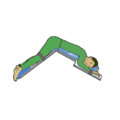Surgical positions
Stomping gait is a type of gait abnormality where the person appears to be stomping when they walk. This is often due to a condition known as peripheral neuropathy, which affects the nerves in the legs and feet.
Causes[edit]
Stomping gait can be caused by a variety of conditions, including:
- Peripheral neuropathy: This is a condition where the peripheral nerves, which are the nerves outside of the brain and spinal cord, are damaged. This can lead to a variety of symptoms, including a stomping gait.
- Charcot-Marie-Tooth disease: This is a group of inherited disorders that affect the nerves in the arms and legs.
- Spinal cord injury: An injury to the spinal cord can disrupt the signals between the brain and the legs, leading to a stomping gait.
- Stroke: A stroke can damage the part of the brain that controls movement, leading to a variety of gait abnormalities, including a stomping gait.
Symptoms[edit]
The main symptom of a stomping gait is a heavy, stomping walk. Other symptoms can include:
- Difficulty lifting the foot off the ground
- Dragging the foot or feet
- Difficulty with balance
- Numbness or tingling in the legs or feet
Treatment[edit]
Treatment for a stomping gait will depend on the underlying cause. This can include:
- Physical therapy: This can help to improve strength and balance.
- Occupational therapy: This can help to improve the ability to perform daily activities.
- Medication: This can help to manage symptoms such as pain or numbness.
- Surgery: In some cases, surgery may be needed to treat the underlying cause of the stomping gait.
See also[edit]
Ad. Transform your life with W8MD's Budget GLP-1 injections from $75


W8MD offers a medical weight loss program to lose weight in Philadelphia. Our physician-supervised medical weight loss provides:
- Weight loss injections in NYC (generic and brand names):
- Zepbound / Mounjaro, Wegovy / Ozempic, Saxenda
- Most insurances accepted or discounted self-pay rates. We will obtain insurance prior authorizations if needed.
- Generic GLP1 weight loss injections from $75 for the starting dose.
- Also offer prescription weight loss medications including Phentermine, Qsymia, Diethylpropion, Contrave etc.
NYC weight loss doctor appointmentsNYC weight loss doctor appointments
Start your NYC weight loss journey today at our NYC medical weight loss and Philadelphia medical weight loss clinics.
- Call 718-946-5500 to lose weight in NYC or for medical weight loss in Philadelphia 215-676-2334.
- Tags:NYC medical weight loss, Philadelphia lose weight Zepbound NYC, Budget GLP1 weight loss injections, Wegovy Philadelphia, Wegovy NYC, Philadelphia medical weight loss, Brookly weight loss and Wegovy NYC
|
WikiMD's Wellness Encyclopedia |
| Let Food Be Thy Medicine Medicine Thy Food - Hippocrates |
Medical Disclaimer: WikiMD is not a substitute for professional medical advice. The information on WikiMD is provided as an information resource only, may be incorrect, outdated or misleading, and is not to be used or relied on for any diagnostic or treatment purposes. Please consult your health care provider before making any healthcare decisions or for guidance about a specific medical condition. WikiMD expressly disclaims responsibility, and shall have no liability, for any damages, loss, injury, or liability whatsoever suffered as a result of your reliance on the information contained in this site. By visiting this site you agree to the foregoing terms and conditions, which may from time to time be changed or supplemented by WikiMD. If you do not agree to the foregoing terms and conditions, you should not enter or use this site. See full disclaimer.
Credits:Most images are courtesy of Wikimedia commons, and templates, categories Wikipedia, licensed under CC BY SA or similar.
Translate this page: - East Asian
中文,
日本,
한국어,
South Asian
हिन्दी,
தமிழ்,
తెలుగు,
Urdu,
ಕನ್ನಡ,
Southeast Asian
Indonesian,
Vietnamese,
Thai,
မြန်မာဘာသာ,
বাংলা
European
español,
Deutsch,
français,
Greek,
português do Brasil,
polski,
română,
русский,
Nederlands,
norsk,
svenska,
suomi,
Italian
Middle Eastern & African
عربى,
Turkish,
Persian,
Hebrew,
Afrikaans,
isiZulu,
Kiswahili,
Other
Bulgarian,
Hungarian,
Czech,
Swedish,
മലയാളം,
मराठी,
ਪੰਜਾਬੀ,
ગુજરાતી,
Portuguese,
Ukrainian




